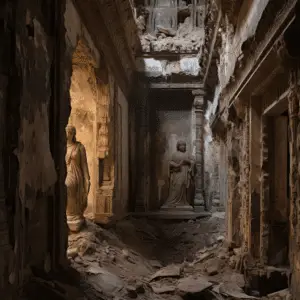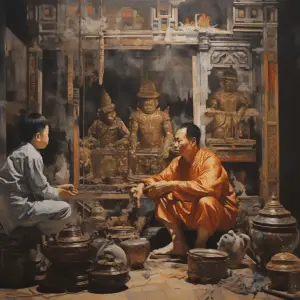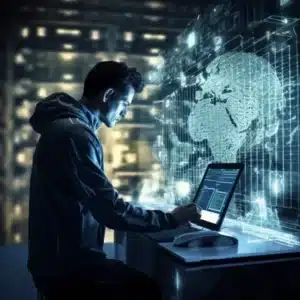
AI and Cultural Preservation: Safeguarding Heritage
Safeguarding cultural heritage, Artificial Intelligence (AI) has emerged as a powerful tool in various fields, and cultural preservation is no exception. As the world becomes increasingly interconnected, preserving cultural heritage has become crucial in maintaining the identity, history, and traditions of communities. With the advent of AI, preserving and safeguarding cultural heritage has become more efficient, accurate, and accessible.
AI technologies provide significant advancements in several aspects of cultural preservation, such as digitization, restoration, and interpretation. One key area where AI excels is in digitizing and archiving historical artifacts and documents. Through advanced image recognition algorithms, AI can automatically analyze and categorize vast collections of photographs, manuscripts, and other cultural artifacts, making them more accessible to historians, researchers, and the general public.
Moreover, AI helps bridge the language barrier by enabling automatic translation of historical texts. With machine learning algorithms, AI systems can analyze and decipher ancient scripts, translating them into modern languages. This breakthrough allows historians and linguists to unlock valuable insights from texts that were previously difficult to decipher due to linguistic or technical challenges.
AI in cultural preservation

Another remarkable application of AI in cultural preservation is in the restoration of deteriorating artifacts or artworks. By examining high-resolution images of damaged works, AI algorithms can reconstruct missing or faded parts, providing conservators with invaluable insights for physical restoration. AI can analyze visual cues, color patterns, and artistic techniques to reproduce damaged sections, reviving the original glory of the artwork.
The preservation of intangible cultural heritage is equally important. AI can help in the documentation and safeguarding of traditional practices, rituals, music, and storytelling. By using machine learning algorithms, AI can analyze audio and video recordings, identifying patterns and characteristics unique to the cultural practices being documented. In this way, AI allows communities to record and transmit their traditional knowledge to future generations, ensuring cultural continuity.
AI algorithms can also assist in the reconstruction and interpretation of cultural heritage sites that have been damaged or lost over time. By analyzing historical data and images, AI systems can generate realistic 3D models of archaeological sites, buildings, or even entire cities. Safeguarding cultural heritage technology offers archaeologists and historians valuable insights into the past, providing a virtual glimpse of ancient civilizations.
In conclusion, AI has proven to be a valuable tool in the domain of cultural preservation. Its ability to digitize artifacts, translate historical texts, restore artworks, document intangible heritage, and reconstruct lost sites makes it an essential asset in safeguarding our collective heritage. While AI cannot replace the expertise and human touch in cultural preservation, it enhances our capabilities and opens new possibilities for safeguarding and celebrating our diverse cultures for generations to come.
How can AI technologies be utilized to safeguard cultural heritage and preserve it for future generations?
AI technologies can be utilized in several ways to safeguard cultural heritage and preserve it for future generations:
1. Digital Preservation
AI can be used to digitize and create 3D models of artifacts, historical sites, and monuments. This allows for their preservation in a digital format, preventing damage or loss due to natural disasters or human intervention.
2. Conservation and Restoration
AI-powered algorithms can analyze and understand patterns of deterioration in historical artifacts and suggest appropriate conservation and restoration techniques. This helps in the preservation of delicate artifacts and ensures their longevity.
3. Document Analysis and Translation
AI can assist in analyzing and translating ancient texts, documents, and inscriptions. This helps in understanding and preserving the knowledge contained within them, even if the original language is no longer widely understood.
4. Visual and Audio Reconstruction
AI can reconstruct and restore damaged or fragmented visual and audio representations of cultural heritage. This includes restoring old photographs, reconstructing missing parts of artworks, or even recreating ancient music and languages.
5. Data Analysis for Research
AI algorithms can analyze large amounts of data related to cultural heritage, such as archaeological surveys, historical documents, or museum records. Safeguarding cultural heritage helps researchers to gain insights and make connections between different artifacts or historical events, enhancing our understanding of our cultural past.
6. Virtual Reality and Augmented Reality Experiences
AI technologies can be used to create immersive virtual reality (VR) or augmented reality (AR) experiences that allow people to explore and interact with cultural heritage sites or artifacts virtually. This helps in making cultural heritage accessible to a wider audience and promoting education and awareness.
7. Predictive Analysis and Risk Assessment
AI can analyze various data points and patterns to predict potential risks or threats to cultural heritage sites or artifacts. This enables authorities to take preventive measures and safeguard cultural heritage against human or natural disasters.
Overall, AI technologies have the potential to significantly contribute to the preservation and safeguarding of cultural heritage by offering efficient and innovative tools for documentation, restoration, knowledge preservation, and wider accessibility.
What role does AI play in documenting, maintaining, and restoring cultural artifacts and architectural structures?
AI plays a significant role in documenting, maintaining, and restoring cultural artifacts and architectural structures. Here are some specific ways AI contributes:
1. Imaging and scanning
AI helps in the digitization of cultural artifacts and architectural structures through advanced imaging and scanning techniques. AI algorithms can enhance and interpret images, allowing for better analysis and preservation of delicate or damaged items.
2. Data analysis and pattern recognition
AI algorithms can analyze vast amounts of data and identify patterns, allowing for better cataloging and classification of artifacts. This helps in organizing and maintaining extensive collections, making them easily accessible for research and preservation.
3. Conservation and restoration
AI techniques like machine learning and computer vision aid in the restoration of aging or damaged cultural artifacts and architectural structures. By analyzing historical data and patterns, AI algorithms can suggest the most appropriate restoration techniques, materials, and processes.
4. Virtual reality and augmented reality
AI-powered VR and AR technologies offer immersive experiences that allow people to explore cultural artifacts and architectural structures virtually. These technologies provide an opportunity to document and preserve delicate or inaccessible structures, ensuring their legacy is safely recorded for future generations.
5. Language translation and interpretation
AI language processing technologies enable real-time translation and interpretation of historical texts or inscriptions, aiding in the understanding and documentation of cultural artifacts and architectural structures in different languages.
6. Predictive maintenance
AI can assist in the maintenance of architectural structures by monitoring various factors like vibrations, temperature, and structural integrity. By analyzing this data, AI algorithms can identify potential issues and recommend preventative measures, reducing the risk of damage or deterioration.
Overall, AI plays a pivotal role in documenting, maintaining, and restoring cultural artifacts and architectural structures by leveraging advanced imaging, data analysis, restoration techniques, virtual experiences, language translation, and predictive maintenance. These applications not only aid in the preservation of our cultural heritage but also contribute to broader research and understanding of historical artifacts and structures.
How can AI assist in translating and interpreting ancient languages and scripts, thereby facilitating the preservation of linguistic heritage?

AI can assist in translating and interpreting ancient languages and scripts in several ways, contributing to the preservation of linguistic heritage:
1. Corpus Compilation
AI can aid in the compilation of extensive digital corpora of ancient texts, including archives, manuscripts, inscriptions, and codices. By digitizing and organizing these resources, researchers and scholars can access a broader range of linguistic data to study and understand ancient languages.
2. Automated Transcription
AI techniques, like Optical Character Recognition (OCR), can automate the transcription of ancient scripts from images or scanned documents. This technology can save time and effort for researchers who would otherwise transcribe texts manually.
3. Language Decipherment
In cases where ancient scripts remain undeciphered, AI algorithms can assist in deciphering them. By analyzing patterns, statistical properties, and comparisons with known languages, AI can provide insights into the structure and meaning of previously untranslated texts, aiding linguists and archaeologists in the interpretation process.
4. Machine Translation
AI-powered machine translation systems can be trained on extensive datasets of parallel texts, allowing for automated translation of ancient languages into modern languages. Linguists and historians can use these translations as a starting point for further analysis and interpretation.
5. Natural Language Processing
AI can facilitate the analysis of ancient texts by extracting linguistic features, identifying syntactic structures, and detecting semantic patterns. This can assist researchers in understanding the grammar, vocabulary, and cultural context of the ancient language.
6. Language Learning Tools
AI-powered language learning platforms can be employed to teach ancient languages to a wider audience. These tools can provide interactive and personalized learning experiences, helping individuals grasp linguistic nuances and encouraging the study and preservation of ancient languages.
7. Preservation of Fragile Texts
AI-assisted imaging techniques can enhance the legibility and preservation of ancient texts, especially those that have been damaged or faded over time. By applying image restoration algorithms, AI can extract more information from deteriorated manuscripts or inscriptions, ensuring their longevity.
By combining the strength of AI technologies with the expertise of linguists and scholars, the translation and interpretation of ancient languages can be advanced, contributing to the preservation and understanding of linguistic heritage for future generations.









Thanks for sharing. I read many of your blog posts, cool, your blog is very good.
Very interesting topic, regards for putting up.Blog monry